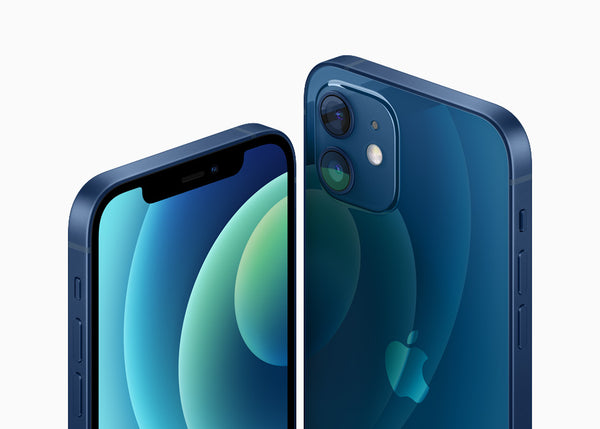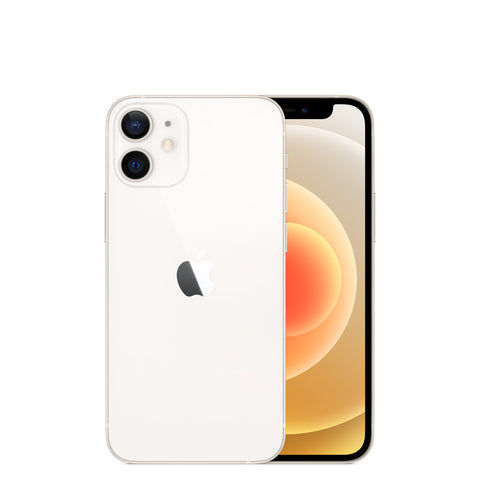At its 2020 launch event on October 13, Apple introduced the iPhone 12 series. And now, we will see what the iPhone 12 and iPhone 12 mini have to offer in 2024.
The iPhone 12 review has been extremely positive, the iPhone 12 mini review is even more so, as this handset provided something excitingly new. This phone accomplishes the feat of being incredibly compact without sacrificing any of its features or specifications, which is no easy feat given how rare such devices are.
Display

Both the iPhone 12 and iPhone 12 mini models utilize the same Super Retina XDR OLED screen technology. However, the iPhone 12 mini has a smaller display.
The main screen size of the iPhone 12 is 6.1 inches, while the smaller iPhone 12 mini has 5.4 inches. The iPhone 12's display isn't among the largest in the smartphone screen size table. On the other hand, the mini would be located very close to the bottom of such a hypothetical chart.
In comparison with the iPhone 12, we can easily reach all four corners with the iPhone 12 mini when using it one-handed. The opposite is true for widescreen media content; the additional room on the bigger phone makes it look better.
That is not to say that the display of the iPhone 12 is noticeably sharper. The pixel density is lower at 1170 x 2532 compared to the mini's 1080 x 2340. While the iPhone 12 manages 460 pixels per inch, the iPhone 12 mini manages 476 pixels per inch, giving it the technically sharpest display of the entire 12 series of iPhones.
At their brightest setting, both phones reach 1200 nits, which is the same as their typical brightness level of 600 nits. While it's not as bright as some Android flagships, it's still more than enough.
Both screens could benefit from a higher refresh rate, but that isn't the case. Compared to their 90Hz and 120Hz Android competitors, both are severely lacking in frame rate. On the other hand, we would argue that this omission is more forgiveable in the iPhone 12 mini, which is smaller and more affordable.
Design

The iPhone 12 mini is virtually indistinguishable from the iPhone 12 in terms of design and build quality. Simply put, it is more compact and lightweight.
The dimensions of the iPhone 12 mini are 131.5 x 64.2 x 7.4 mm, which is approximately 15 mm smaller and 7 mm narrower than the iPhone 12, while maintaining an identical thickness. This gives the mini a chunkier feel than the iPhone 12.
With 164g for the full-size iPhone 12 and 135g for the smaller 12 mini, there is a 29g weight disparity between the two. Neither of these phones is bulky or cumbersome; in fact, they both fit discretely into little bags and pockets.
These two handsets share the same material list. The matte aluminum frames of the two are identical in color—black, white, red, green, and blue. These are between shiny glass surfaces, with toughened nano-crystalline Ceramic Shield screen technology providing 4x front protection.
Both phones have been waterproofed to an IP68 standard, so you can dip them in water for up to 30 minutes without worrying about any damage.
Camera

Surprisingly, the iPhone 12 mini retains the identical dual-camera system as the iPhone 12. This is particularly noteworthy given that the setup in question is among the finest available for smartphones.
Both models feature two 12MP sensors, one of which is an f/1.6 wide sensor and the other an f/2.4 ultra-wide sensor. When you need a broader view, the latter shoots excellent 120-degree shots.
More than anything else, that is evidence of the superiority of Apple's image processing algorithms. With the possible exception of Google, no manufacturer consistently and superbly captures the essence of a scene using a point-and-shoot process.
Apple has also made significant improvements to its low-light calculations for the iPhone 12 range. Among all smartphones, none of the three cameras—including the 12MP selfie cam—capture images as sharp and clear as those captured in Night Mode. You won't have to switch modes every time the light goes out because this is also seamlessly integrated.
A specialized telephoto lens is something that is absent from both camera systems. If you want to take zoomed-in photos that are unbelievably sharp, you will need to upgrade to the iPhone 12 Pro. Right now, you can get close-up shots on the iPhone 12 and the iPhone 12 mini by cropping, but the quality will definitely suffer.
As expected from an Apple product, the video capture quality is superb on both phones. The new Dolby Vision HDR video recording standard greatly improves dynamic range, but the two phones can only record at 30 frames per second (fps) as opposed to the 60 fps that the Pro models offer. Regardless, 4K/60fps footage is still provided as standard, and it is both stable and sharp.
Battery and Charging

Battery capacity is the biggest difference between these phones, aside from screen size and dimensions.
The iPhone 12 and 12 mini have 2,815mAh and 2,227mAh batteries, respectively. We usually get through a day of moderate use without plugging in.
iPhones are known for conserving power in standby, and the iPhone 12 and 12 mini could go to bed with half a tank left, depending on usage. About 20% remains after moderate to intensive use.
However, the smaller battery of the iPhone 12 mini simply cannot stand up to such rigors as the larger battery of the iPhone 12. In both cases, the frequent reliance on mobile networks over Wi-Fi would drain the juice more thoroughly. A lot of power is lost when you use 5G access.
Those who consume a lot of media or play games will prefer the iPhone 12. You get more screen space and a longer battery life.
Both phones support 20W wired and wireless charging (charger sold separately). The iPhone 12 supports 15W, and the iPhone 12 mini supports 12W. Apple's revised MagSafe standard lets you attach magnetized chargers and accessories to both phones' backs.
Performance

It is already impressive that the iPhone 12 and iPhone 12 mini share a top-notch camera system. It is very interesting that they also have identical performance.
The A14 Bionic chipset is housed in the iPhone 12 mini, in addition to the iPhone 12, iPhone 12 Pro, and iPhone 12 Pro Max. Supporting this is 4 GB of RAM, which is the same as what's found in the iPhone 12.
With equally scorching speeds, the iPhone 12 and iPhone 12 mini breeze through image processing tasks, 3D gaming, and multitasking with contempt.
It isn't really a question of how well they run today's applications because of the A14 Bionic's sheer performance headroom. The focus instead shifts to our smartphone habits in the coming two or three years. After a few years, you can probably expect the iPhone 12 and 12 mini to feel just as snappy and responsive as they do now.
5G connectivity is another feature that both phones share. Apple has confirmed that the iPhone 12 and iPhone 12 mini can achieve theoretical speeds of up to 4Gbps in real-world scenarios, proving that they support 5G. So these phones can take advantage of 5G to its maximum capacity on a variety of networks worldwide.
Conclusion
The iPhone 12 mini satisfies a large minority of users who want a small flagship phone. Its capability compared to the iPhone 12 is remarkable.
There's little to lose by choosing the iPhone 12 mini over the iPhone 12. Performance, build, and camera quality are identical and near the top of the smartphone industry.
If you are an avid gamer, heavy media consumer, or power user, the iPhone 12 is still the superior option. Extra screen space and battery life will improve your experience.
However, it's really hard to justify spending an additional $100 on a phone that serves the same purpose for lighter and more occasional users. It is true that size does matter, but not by that much.
(Image credit: Apple)

